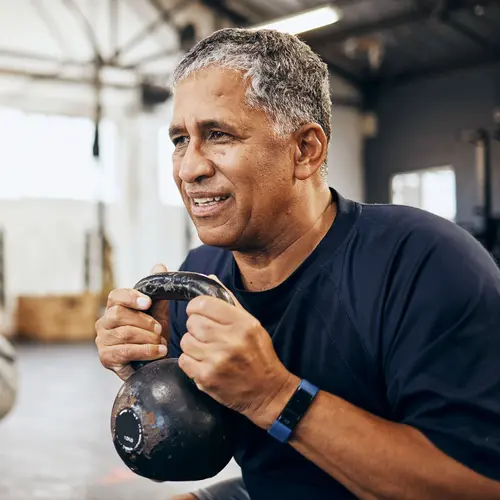You hear it all the time: Exercise is one of the most important things you can do for your health. It’s “the closest thing we have to a miracle drug,” says Gene Shirokobrod, DPT, co-founder of Recharge in Ellicott City, MD. “It has significant benefits and very few side effects.”
Those benefits go far beyond your physical body. Exercise can boost your mood, help you sleep better, and keep your body humming smoothly, not to mention reduce your risk of chronic disease.
How much does it take? For adults, experts recommend at least 150 minutes of moderate-intensity aerobic exercise per week (which you can split up any way you like, such as 30 minutes a day 5 days a week) and 2 days of strength training activities.
You don’t have to lift a certain amount of weight or run a specific number of miles. And if you’re not active now, start slowly.
“A little bit goes a long way to getting started and building good habits. It makes a big difference,” says Mark Hutchinson, MD, president of the American College of Sports Medicine Foundation.
Here are nine of the top benefits of exercise.
It Makes You Resilient
Exercise is crucial to building and maintaining strong bones and muscles. Typically, you start to lose bone mass in your 40s, and more than half of Americans over the age of 50 have osteoporosis, a condition where your bones become weak and brittle.
Exercise, specifically weight-bearing exercise, counteracts the natural deterioration of bone density, Shirokobrod says. Activities like fast walking, running, and resistance training load your bones and joints and force them to build back up.
Muscle mass starts to decrease after age 30, too. But Shirokobrod says it’s not a foregone conclusion. A strength training plan that gradually progresses, along with getting enough quality protein, can offset that loss.
It Improves Cardiovascular Health
Your heart is a muscle, and it’s no surprise that physical activity plays a role in cardiovascular health. For example, exercise like high-intensity interval training improves heart rate variability, the difference in time between your heartbeats. It’s often used as a marker of how well your cardiovascular system performs. More variation means that your heart can easily speed up or slow down in order to adapt to different situations.
It Reduces Your Risk of Death
Yes, we’re all mortal. But people who are physically active, whether it’s aerobic exercise or strength training, are more likely to live longer. Exercise is even protective for people with cancer, trimming the risk of dying in a certain time period by up to 35%. That’s because sedentary lifestyles can lead to risk factors that can lead to life-threatening problems.
Exercise, on the other hand, teaches your body to adapt to stress, and everything starts to work better including your heart, lungs, blood vessels, kidneys.
“You clear things out of your system better, too,” Hutchinson says. “You have less issues of bad cholesterol and heart health. You have a lower risk of high blood pressure and other cardiac problems.”
It Boosts Your Mood
While you’ve probably heard the term runner’s high, you can get an exercise-induced mood boost from any workout. Physical activity primes your brain for this.
Exercise increases the amount of endocannabinoids in the body. These molecules are similar to the compound found in cannabis and can lead to a sense of well-being and even euphoria, especially after 30 minutes or more of moderate-intensity exercise. Aerobic exercise and resistance training have both been shown to significantly ease symptoms tied to depression and anxiety.
It Keeps Your Blood Sugar in Check
If you have diabetes, exercise may help you reduce the amount of medication you may need to manage the condition, Hutchinson notes. Physical activity can enhance your sensitivity to insulin, the hormone that helps your body manage blood sugar. Both high- and moderate-intensity exercise improves glucose metabolism and insulin sensitivity in people with type 2 diabetes or prediabetes.
It Improves Brain Health
Physical activity leads to better circulation in the brain. Greater blood flow brings more oxygen and nutrients to the brain while clearing away waste products. That may be why studies have found that exercise improves cognitive and executive function.
Exercise also triggers the growth of new nerve cells or neurons, which can lead to changes in brain structure that promotes learning. It turns out that exercise changes the structure of your brain too. Researchers have found that in people with better cardiovascular fitness, the white matter in their brains had fewer lesions and less deterioration.
It Relieves Stress
Activities like yoga do more than make you limber. The mind-body connection can improve mental health, according to Hutchinson.
Studies have shown that yoga activates the parasympathetic nervous system, a network of nerves that tells the body to relax. The combination of yoga poses and breathing exercises improved heart rate variability and stress levels. Among medical students, a regular program of yoga lowered stress and led to feelings of focus, happiness, and well-being.
It Lowers Your Risk of Falls
Falls can lead to major injuries and hospitalization, especially for older adults. “The No. 1 reason people will be debilitated and ultimately die is because of falls,” Shirokobrod says. That is, the long-term consequences of being bedridden after a fall is a big risk for older adults.
But studies show that the risk of fall-related injuries is up to 40% lower if you are regularly active. Balance exercises and strength training can both safeguard your body against falls and help you rebound faster if you do fall, Shirokobrod says.
It Enhances Your Quality of Life
Ultimately, regular exercise means a higher quality of life, both Hutchinson and Shirokobrod say. With greater endurance, strength, and body systems that work more efficiently, you can do more of the things that you enjoy in life for a longer time.


